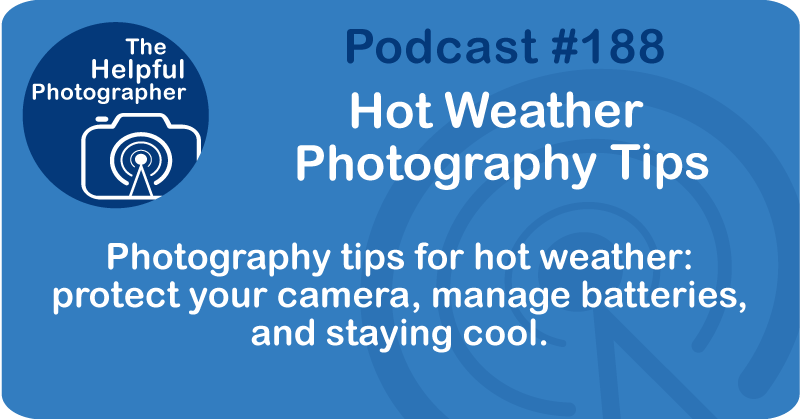Hot Weather Photography Tips #188

Today I wanna talk about shooting in warm weather. Hot, sticky, humid conditions can really test you and your camera. A couple of months ago, I was in Vietnam, and while it wasn't quite hotter than Haiti's, it was definitely close. Between the humidity and the heat radiating off the rice paddies, I learned a few new things about what happens to your gear and your body when you're out shooting in those conditions. First, let's talk about your camera.
The good news is that your camera body itself can generally handle the heat pretty well. To be clear, it's not the glass, it's not the metal, and it's not the plastic housing that's the problem. The real weak spot is your battery. Camera batteries are only rated to work within a certain temperature range, usually somewhere between negative 20 degrees Celsius and 60 degrees Centigrade. That's negative four Fahrenheit to 140 degrees Fahrenheit. That's a pretty wide range. However, you should note, most manufacturers will tell you that the actual operating range of your camera is somewhere between 0 degrees Celsius and 45 degrees Celsius, or 30 degrees Fahrenheit to 113 degrees Fahrenheit.
The reason is because the last set of numbers that I gave you is the temperature range in which you want to be charging your batteries. By giving it that smaller scope, manufacturers know that you're always going to be okay, whether you're actually using the battery or charging the battery. In Vietnam, I found it interesting that in high heat, my batteries behave the way they do in cold temperatures. They drain much faster. But unlike cold temperatures, in high heat, your batteries can overheat, which will apparently reduce their lifespan. So if you're shooting in either extreme, make sure you bring extra batteries and keep them in a temperate spot, like inside your bag in hot conditions, or in a pocket close to your body in cold conditions.
Now, there's another issue in high heat—long exposures. Your camera sensor basically works like a little electrical circuit. The longer it's active and the hotter it gets, the more digital noise it produces. And that's why astrophotographers often shoot shorter exposures and stack them later. It helps reduce the noise buildup that happens when the sensor stays on too long. When I was shooting long exposures in Vietnam, some as long as four minutes with ND filters, I started seeing hot pixels creeping into my image. These are little, small, random bright specks that appear on your image when the sensor overheats. Unfortunately, there's not a lot you can do about it if you need that long exposure, but it's something to keep in mind if you're shooting in extreme heat.
But honestly, the biggest challenge for me wasn't the gear—it was me. Standing out there under the blazing sun, waiting for a long exposure to finish was brutal, even though it was only four minutes. So let's talk about personal safety and comfort, because you're not going to get that shot if you faint next to your camera.
First off, wear a hat—a wide-brimmed hat if you can. It makes a world of difference. I know I look like a total dork with my big brimmed hat, but I would have completely fried without mine. I was frying as it was. Second, cover up. I'm a sunscreen person, but lately, I've switched to UV-protective clothing. Brands like Patagonia, Under Armour, and Columbia make these long-sleeve shirts that are breathable and actually help keep you cool. Sounds counterintuitive, but they do work, especially in humid climates. And of course, stay hydrated. Even if you think you're fine, drink more than you need. Again, you don't want to be that person fainting next to your tripod.
A quick note about condensation—from cold to hot, or vice versa. Sometimes you'll be in an air-conditioned hotel or car, step outside into a humid environment, and suddenly your lens fogs up like a bathroom mirror. That's condensation, and it's totally normal. Your gear needs time to adjust to the new temperature. What I like to do is take my camera bag outside, leave it closed for a few minutes, letting everything warm up gradually before I start shooting. Slow transitions will help prevent condensation buildup.
On my recent trip to Costa Rica and Colombia to shoot birds, I actually learned a really neat trick from some of the bird guides. Instead of wiping condensation off their binocular lenses, which just smears it and takes forever to dry, they use a blower. It's genius. A blower uses air that's already the same temperature as the environment, so it helps evaporate the moisture more naturally without pushing it around. Once it's mostly dry, then you can gently use a clean, dry microfiber cloth or lens tissue if you need to.
So, to wrap it all up—your camera can handle the heat, but your battery can't. Long exposures and high temperatures equal more sensor noise. Take care of yourself: wear a hat, UV shirt, sunscreen, and drink plenty of water. Manage condensation by letting your gear warm up slowly and using a blower instead of a wipe. At the end of the day, your camera is just a tool. You're the one who has to survive out there to make the shot happen.
All right, that's it for today. I hope that was helpful. Stay safe, stay hydrated, and keep on shooting, no matter what the weather throws at you.











